The seaside pleasure pier
Page 1 of 1
 The seaside pleasure pier
The seaside pleasure pier
The return of the seaside pier
They had their glory days in the 1950s. But then Britain's magnificent seaside piers were allowed to fall into disrepair. Now they're staging a comeback
Jonathan Glancey guardian.co.uk, Sunday 21 June 2009 21.30 BST

A murmuration of starlings over Brighton Pier at sunset. Photograph: Linda Nylind
It is the longest pleasure pier in the world – so long, in fact, that it even has its own train, the Sir John Betjeman, ready to whisk you off to its furthest point, 1.3 miles out over the waltzing waves. For 23 years, this little train has been trundling along the iron and timber expanse of Southend pier at little more than the pace of a seaside donkey, ferrying day-trippers and holiday-makers out to a stop by the water's edge – for no particular purpose except to see the sea, scoff ice cream, and perhaps to fish, but mostly to while away the time, as the gulls circle overhead and the smell of vinegary chips mingles with the salty air.
Although it was chiefly built to catch the sun, on a foggy day the end of Southend pier can be one of the most bewitching places in Britain. That view of a seemingly infinite expanse of tidal waters disappears, while behind you Southend itself is nowhere to be seen – the pier stretches into nothingness. It's just you and the sound of water slapping against the limbs of this great Victorian plaything, as the odd mournful hooter sounds out there in the murk.
Although there are pleasure piers elsewhere in the world, all took their cue from the essentially Victorian piers of England and Wales. True, there are piers in Scotland and Northern Ireland, yet these are very much working jetties for ships, ferries and trawlers, not people taking their leisure. Britain's first promenade pier, at Ryde on the Isle of Wight, opened in 1814. No longer cut off by its sandbanks at low tide, the town quickly prospered and other destinations – realising that great stretches of the English and Welsh coastline are surprisingly (if erratically) balmy – followed suit.
The piers acted like magnets to steamers laden with visitors who would have otherwise passed them by. Not only did they offer magical strolls across the shimmering sea, some boasted fanciful, full-bodied buildings, their generous curves and swirls contrasting with the rigid, skeletal structures beneath them. The best, like Brighton's West Pier, an architectural wonder still awaiting rebuilding after two fires, hosted concerts and music hall turns, and sprouted elegant cafes, as well as any number of popular amusements.
"The pier is Southend," said Betjeman, "and Southend is the pier." The poet laureate, who died in 1984, was first honorary president of the National Piers Society (NPS) and he knew Southend well in its glory days. These hit their peak in 1949, when, helped by the arrival of railways and cheap fares, more than 5 million people passed through the pier's turnstiles. Today, the figure is a mere 250,000.
Since the 1960s, when cheap charter holidays saw people jetting off to Iberian coasts, Britain's piers have been in decline. Many are shabby and in need of renovation, unloved and all but forgotten, left to the mercy of the sea. But there are signs that this is beginning to change. With many people thinking of holidaying at home, it looks as if the seaside pier, that odd marriage of playful architecture and ingenious engineering, is staging a comeback. And now the daddy of them all, Southend pier, is joining the charge.
Citing the revival of St Ives over the last two decades, Southend-on-Sea council last month launched a £5m competition to rebuild its pier head, destroyed by fire in 2005. The winning architect, to be chosen at the end of the summer, will provide new buildings to house new entertainments, in the hope that a reborn pier will help the biggest town in Essex (population: 160,000) move towards a brightly cultured future, shifting the focus away from its grim 1960s office blocks, some of which house the headquarters of HM Revenue and Customs.
Southend is one of 55 surviving pleasure piers in England and Wales. The majority sit on the sunnier shores of the south-east and west of England; some are starting to flourish anew, others, including those at Felixstowe, Hastings and Swanage, are in danger of being overlooked, although their fortunes are watched over assiduously by the NPS. The organisation has just officially named Saltburn pier, the last surviving one in Yorkshire, its pier of the year. Built in 1869, and rescued with Lottery money in 2001, the pier now boasts a small amusement arcade. This delightful structure is best viewed after sunset, when it is lit from below and seems to hover on a beam of light.
Equally exciting is the new cafe at Deal pier, on the Kent coast, a sleek timber and glass pavilion that's a far cry from the 1950s world of kiss-me-quick hats, sticky rock and stewed tea. Designed by London-based Niall McLaughlin, its crisscrossing beams and generous windows show how a little energy and innovation can enhance a pier no end, especially one as gaunt as concrete-coated Deal. In the early evening, with the sea washing towards you, this is a great place to sit down and savour a real coffee.
While there will always be an enjoyable clash between seaside jollity, or even vulgarity, and refined design, Deal shows that there is a place for a calmer, more contemplative breed of seaside architecture: it's proof that modern architects can do piers. And McLaughlin's timbers are designed to age gracefully. Battered by the sea, sun, wind and rain, they will turn from ruddy brown to a shade of silver that will play off the waves in the sea.
McLaughlin joins a distinguished line of British pier architects. The most celebrated was Eugenius Birch, from London, who designed 14 between 1853 and his death in 1884. The cast-iron posts of his piers were revolutionary, being screwed, rather than pounded, into seabeds for greater, more enduring strength. His finest was Brighton West, whose iron posts continue to haunt the seafront. Its eye-catching and still unrivalled pavilions were designed in fairytale Indian styles, Birch having worked on the construction of the Calcutta to Delhi railway. Although Brighton West has gone, you can still catch sight of Birch's architectural invention at Eastbourne. The town's enchanting pier, with its perfect domes, gables and turrets, is currently up for sale. Yours for £5m.
If not the longest, then the world's most futuristic pier must surely be the 300-metre long example Foster and Partners have designed for Rimini on Italy's Adriatic coast. Slithering over the waves like some glistening, robotic serpent, the metallic pier will draw its energy from natural sources so that it will be a gently dramatic addition to this tourist hotspot.
Southend-on-Sea is a more challenging prospect. For all its ambitions, the town is never going to be St Ives. It has mud flats rather than golden sands. Its famed Golden Mile comprises little more than amusement arcades, gift shops and fast-food joints. Even its name is a bit of a fib: that's actually the Thames Estuary out there, awash with tankers, sewage and unexploded bombs left over from the war.
Having said that, the Grade II-listed pier (its design has never been more than functional, but its startling length and wave-defying engineering make it of great historical interest) is full of potential. If the council is brave and commissions bold, imaginative architects, Southend could yet give towns like Brighton a run for their money, as the crowds flock once again to the world's longest pier.
guardian.co.uk © Guardian News and Media Limited 2011
They had their glory days in the 1950s. But then Britain's magnificent seaside piers were allowed to fall into disrepair. Now they're staging a comeback
Jonathan Glancey guardian.co.uk, Sunday 21 June 2009 21.30 BST

A murmuration of starlings over Brighton Pier at sunset. Photograph: Linda Nylind
It is the longest pleasure pier in the world – so long, in fact, that it even has its own train, the Sir John Betjeman, ready to whisk you off to its furthest point, 1.3 miles out over the waltzing waves. For 23 years, this little train has been trundling along the iron and timber expanse of Southend pier at little more than the pace of a seaside donkey, ferrying day-trippers and holiday-makers out to a stop by the water's edge – for no particular purpose except to see the sea, scoff ice cream, and perhaps to fish, but mostly to while away the time, as the gulls circle overhead and the smell of vinegary chips mingles with the salty air.
Although it was chiefly built to catch the sun, on a foggy day the end of Southend pier can be one of the most bewitching places in Britain. That view of a seemingly infinite expanse of tidal waters disappears, while behind you Southend itself is nowhere to be seen – the pier stretches into nothingness. It's just you and the sound of water slapping against the limbs of this great Victorian plaything, as the odd mournful hooter sounds out there in the murk.
Although there are pleasure piers elsewhere in the world, all took their cue from the essentially Victorian piers of England and Wales. True, there are piers in Scotland and Northern Ireland, yet these are very much working jetties for ships, ferries and trawlers, not people taking their leisure. Britain's first promenade pier, at Ryde on the Isle of Wight, opened in 1814. No longer cut off by its sandbanks at low tide, the town quickly prospered and other destinations – realising that great stretches of the English and Welsh coastline are surprisingly (if erratically) balmy – followed suit.
The piers acted like magnets to steamers laden with visitors who would have otherwise passed them by. Not only did they offer magical strolls across the shimmering sea, some boasted fanciful, full-bodied buildings, their generous curves and swirls contrasting with the rigid, skeletal structures beneath them. The best, like Brighton's West Pier, an architectural wonder still awaiting rebuilding after two fires, hosted concerts and music hall turns, and sprouted elegant cafes, as well as any number of popular amusements.
"The pier is Southend," said Betjeman, "and Southend is the pier." The poet laureate, who died in 1984, was first honorary president of the National Piers Society (NPS) and he knew Southend well in its glory days. These hit their peak in 1949, when, helped by the arrival of railways and cheap fares, more than 5 million people passed through the pier's turnstiles. Today, the figure is a mere 250,000.
Since the 1960s, when cheap charter holidays saw people jetting off to Iberian coasts, Britain's piers have been in decline. Many are shabby and in need of renovation, unloved and all but forgotten, left to the mercy of the sea. But there are signs that this is beginning to change. With many people thinking of holidaying at home, it looks as if the seaside pier, that odd marriage of playful architecture and ingenious engineering, is staging a comeback. And now the daddy of them all, Southend pier, is joining the charge.
Citing the revival of St Ives over the last two decades, Southend-on-Sea council last month launched a £5m competition to rebuild its pier head, destroyed by fire in 2005. The winning architect, to be chosen at the end of the summer, will provide new buildings to house new entertainments, in the hope that a reborn pier will help the biggest town in Essex (population: 160,000) move towards a brightly cultured future, shifting the focus away from its grim 1960s office blocks, some of which house the headquarters of HM Revenue and Customs.
Southend is one of 55 surviving pleasure piers in England and Wales. The majority sit on the sunnier shores of the south-east and west of England; some are starting to flourish anew, others, including those at Felixstowe, Hastings and Swanage, are in danger of being overlooked, although their fortunes are watched over assiduously by the NPS. The organisation has just officially named Saltburn pier, the last surviving one in Yorkshire, its pier of the year. Built in 1869, and rescued with Lottery money in 2001, the pier now boasts a small amusement arcade. This delightful structure is best viewed after sunset, when it is lit from below and seems to hover on a beam of light.
Equally exciting is the new cafe at Deal pier, on the Kent coast, a sleek timber and glass pavilion that's a far cry from the 1950s world of kiss-me-quick hats, sticky rock and stewed tea. Designed by London-based Niall McLaughlin, its crisscrossing beams and generous windows show how a little energy and innovation can enhance a pier no end, especially one as gaunt as concrete-coated Deal. In the early evening, with the sea washing towards you, this is a great place to sit down and savour a real coffee.
While there will always be an enjoyable clash between seaside jollity, or even vulgarity, and refined design, Deal shows that there is a place for a calmer, more contemplative breed of seaside architecture: it's proof that modern architects can do piers. And McLaughlin's timbers are designed to age gracefully. Battered by the sea, sun, wind and rain, they will turn from ruddy brown to a shade of silver that will play off the waves in the sea.
McLaughlin joins a distinguished line of British pier architects. The most celebrated was Eugenius Birch, from London, who designed 14 between 1853 and his death in 1884. The cast-iron posts of his piers were revolutionary, being screwed, rather than pounded, into seabeds for greater, more enduring strength. His finest was Brighton West, whose iron posts continue to haunt the seafront. Its eye-catching and still unrivalled pavilions were designed in fairytale Indian styles, Birch having worked on the construction of the Calcutta to Delhi railway. Although Brighton West has gone, you can still catch sight of Birch's architectural invention at Eastbourne. The town's enchanting pier, with its perfect domes, gables and turrets, is currently up for sale. Yours for £5m.
If not the longest, then the world's most futuristic pier must surely be the 300-metre long example Foster and Partners have designed for Rimini on Italy's Adriatic coast. Slithering over the waves like some glistening, robotic serpent, the metallic pier will draw its energy from natural sources so that it will be a gently dramatic addition to this tourist hotspot.
Southend-on-Sea is a more challenging prospect. For all its ambitions, the town is never going to be St Ives. It has mud flats rather than golden sands. Its famed Golden Mile comprises little more than amusement arcades, gift shops and fast-food joints. Even its name is a bit of a fib: that's actually the Thames Estuary out there, awash with tankers, sewage and unexploded bombs left over from the war.
Having said that, the Grade II-listed pier (its design has never been more than functional, but its startling length and wave-defying engineering make it of great historical interest) is full of potential. If the council is brave and commissions bold, imaginative architects, Southend could yet give towns like Brighton a run for their money, as the crowds flock once again to the world's longest pier.
guardian.co.uk © Guardian News and Media Limited 2011

eddie- The Gap Minder
- Posts : 7840
Join date : 2011-04-11
Age : 68
Location : Desert Island
 Re: The seaside pleasure pier
Re: The seaside pleasure pier

Print of Victorian pier in Margate, 1897.

eddie- The Gap Minder
- Posts : 7840
Join date : 2011-04-11
Age : 68
Location : Desert Island
 Re: The seaside pleasure pier
Re: The seaside pleasure pier

Victorian pier at Clevedon, Somerset. England.

eddie- The Gap Minder
- Posts : 7840
Join date : 2011-04-11
Age : 68
Location : Desert Island
 Re: The seaside pleasure pier
Re: The seaside pleasure pier

Palace Pier, Brighton. England. Opened 1n 1899 after eight years of construction.

Palace Pier, Brighton.

Brighton's derelict West Pier, destroyed by fire and high winds.

eddie- The Gap Minder
- Posts : 7840
Join date : 2011-04-11
Age : 68
Location : Desert Island
 Re: The seaside pleasure pier
Re: The seaside pleasure pier
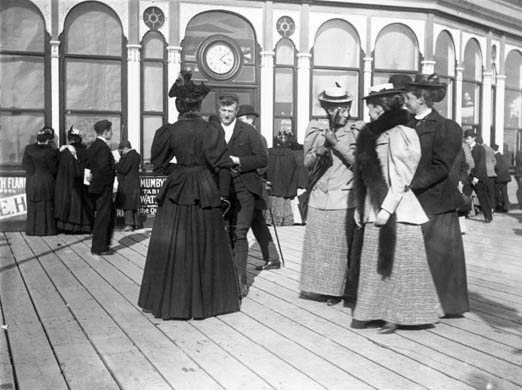
1900, Southsea, UK: Holidaymakers on Clarence pier, which was partly destroyed by bombing in 1941. Plans are afoot to build a 180ft-high wheel called the Solent Eye, a south coast version of the London Eye.

eddie- The Gap Minder
- Posts : 7840
Join date : 2011-04-11
Age : 68
Location : Desert Island
 Re: The seaside pleasure pier
Re: The seaside pleasure pier
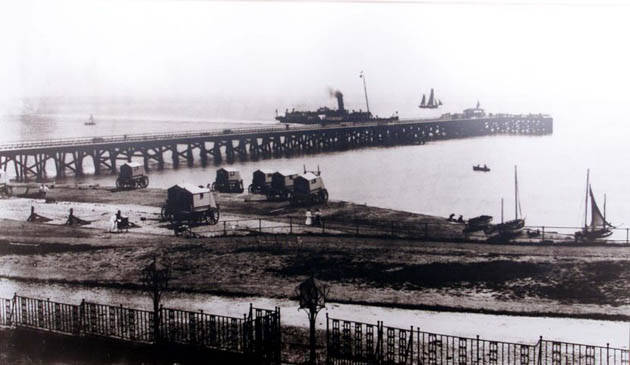
1900, Southwold, UK: The pier which was extended and opened in 2001. Businessman Chris Iredale has spent close to £1m creating the 620ft pier. The original was built in 1900 but fell into disuse in 1979 after decades of storm damage. PA.

eddie- The Gap Minder
- Posts : 7840
Join date : 2011-04-11
Age : 68
Location : Desert Island
 Re: The seaside pleasure pier
Re: The seaside pleasure pier
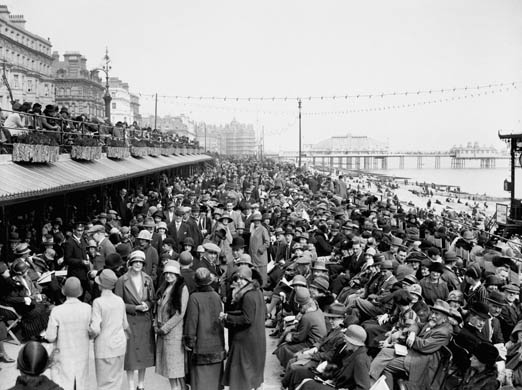
April 3 1926, Eastbourne, UK: Tourists during the Easter holiday.

eddie- The Gap Minder
- Posts : 7840
Join date : 2011-04-11
Age : 68
Location : Desert Island
 Re: The seaside pleasure pier
Re: The seaside pleasure pier
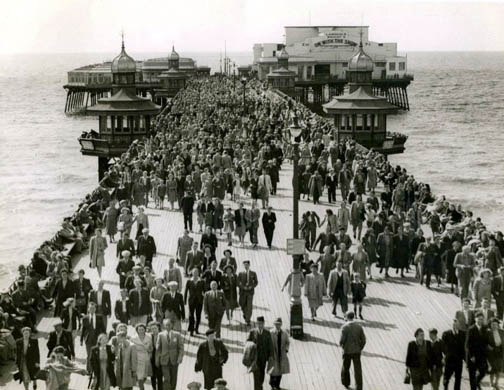
1950s, Blackpool, UK: Revellers crowd the North Pier.

eddie- The Gap Minder
- Posts : 7840
Join date : 2011-04-11
Age : 68
Location : Desert Island
 Re: The seaside pleasure pier
Re: The seaside pleasure pier
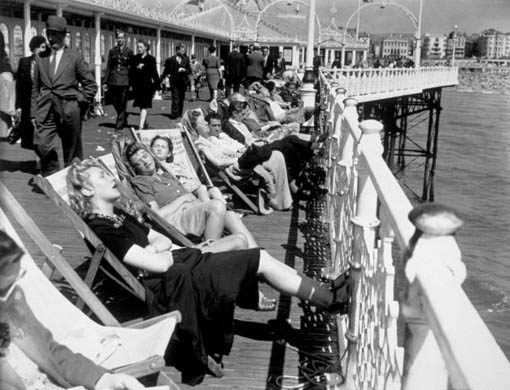
1946 Brighton, UK. The Pier.

eddie- The Gap Minder
- Posts : 7840
Join date : 2011-04-11
Age : 68
Location : Desert Island
 Re: The seaside pleasure pier
Re: The seaside pleasure pier
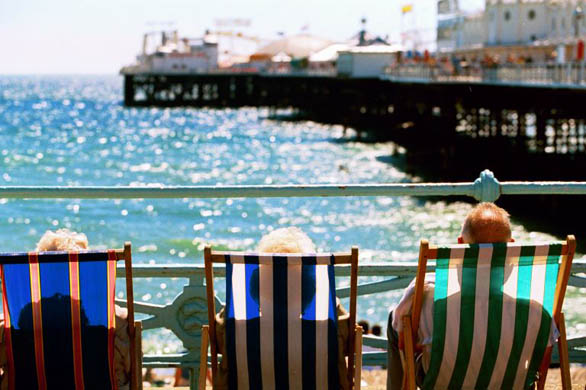
August 21 2000, Brighton, UK: An elderly couple relax in deckchairs by the pier.

eddie- The Gap Minder
- Posts : 7840
Join date : 2011-04-11
Age : 68
Location : Desert Island
 Re: The seaside pleasure pier
Re: The seaside pleasure pier
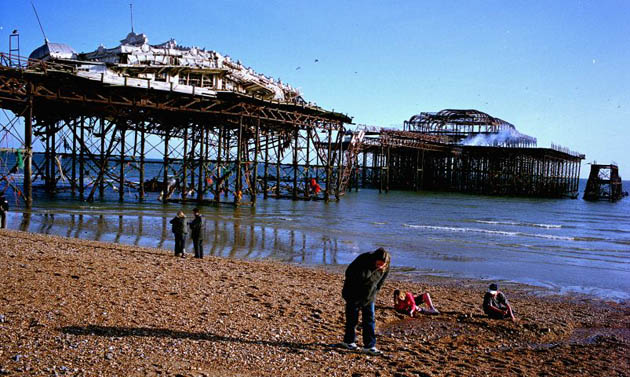
April 1 2003: Brighton, UK: West Pier a week after being damaged by fire.

eddie- The Gap Minder
- Posts : 7840
Join date : 2011-04-11
Age : 68
Location : Desert Island
 Re: The seaside pleasure pier
Re: The seaside pleasure pier
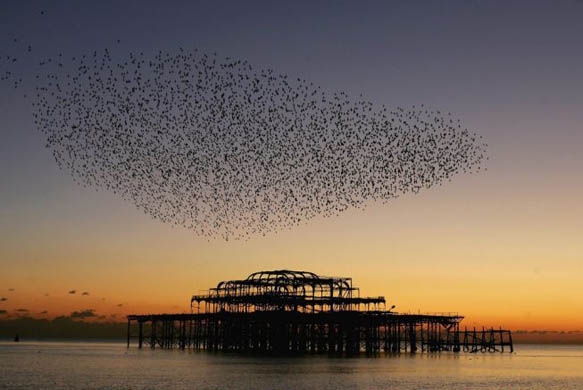
November 2 2006, Brighton, UK: Starlings gather over the derelict West Pier.

eddie- The Gap Minder
- Posts : 7840
Join date : 2011-04-11
Age : 68
Location : Desert Island
 Re: The seaside pleasure pier
Re: The seaside pleasure pier
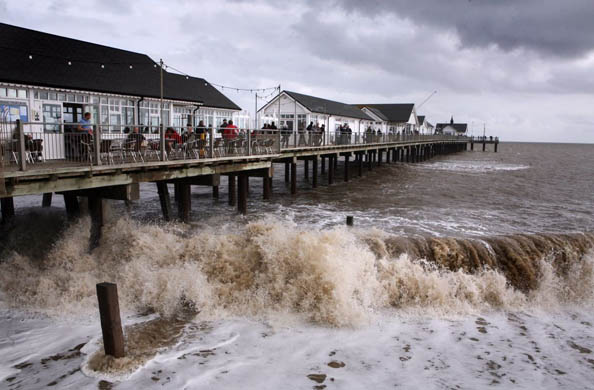
October 1 2007, Southwold, UK: Waves crash onto the beach near the pier.

eddie- The Gap Minder
- Posts : 7840
Join date : 2011-04-11
Age : 68
Location : Desert Island
 Re: The seaside pleasure pier
Re: The seaside pleasure pier
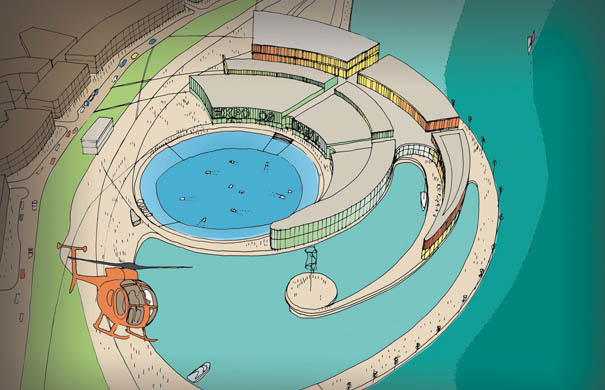
A blueprint for the innovative Beachcomber pier development in Morecambe. Atomikarchitecture.

eddie- The Gap Minder
- Posts : 7840
Join date : 2011-04-11
Age : 68
Location : Desert Island
Page 1 of 1
Permissions in this forum:
You cannot reply to topics in this forum

